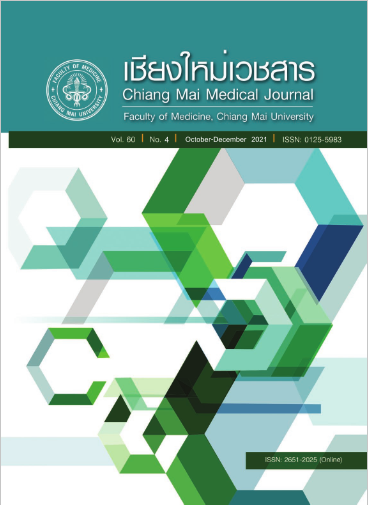The effectiveness of trunk-supporting seat belt in reducing low back muscle fatigue for sea-port crane operators
Keywords:
เข็มขัดนิรภัยพยุงลำตัว ความล้า กล้ามเนื้อหลังส่วนล่าง ผู้ควบคุมเครนAbstract
Objectives To study the effectiveness of trunk-supporting seat belt for reducing low back muscle fatigue.
Methods The study used a single group of volunteers to compare the fatigue of lower back muscles between wearing and not wearing a seat belt to support their torso. The comparison was made by first sitting then leaning the torso forward at an angle of 30 degrees for 30 minutes. The lower back muscles were analyzed by using an electromyography (EMG). An EMG potential was measured on the area of the lumbar erector spinae muscles of twenty medical students between September to November 2020. The data were analyzed using statistics (Matched Pair Statistic).
Results The group study outcome consisted of 4th and 5th year male medical student volunteers from the academic year of 2020. The volunteers who passed the selection criteria totalled twenty people with an average age of 22.75 years. The median difference in EMG potential measured on the lumbar erector spinae was as follows: When the body support belts were in place and then not in place the results were: 58.0 (42.00 - 121.75) hertz and 16.50 (11.25 - 60.75) hertz, respectively, which showed a significant difference. (Z = -3.921 statistic, p < 0.001).
Conclusions The use of seat belts to support the torso can reduce the fatigue of the lower back
muscles of a port crane operator. Crane operation requires the torso to be bent forward at times. Muscle fatigue results can be assessed by using an EMG.
References
Workman compensation fund office. Annual report 2017 Nonthaburi: Workman Compen-sation Fund; 2017.
Social Security Office, Ministry of Labour. The situation work-related accidents and disease 2013-2017. Nonthaburi: Social Security Office; 2018.
Social Security Office. Diagnostic criteria of occupational diseases commemorative edi-tion on the auspicious occasion of his maj-esty the King’S 80th Birthday Anniversary 5 December 2007. Nonthaburi: Social Security Office; 2550.
Akinpelu AO, Odole OO, Olukoya RO. Preva-lence of musculoskeletal pain and health seeking behaviour among occupational driv-ers in Ibadan, Nigeria. African Journal Biomed-ical Research. 2011;14:89-94.
Duthey B. A public health approach to Inno-vation; 2013. (Update on 2004 Background Paper) [Internet]. [cited 2021 April 10]. Avail-able from: https://www.who.int/medicines/areas/priority_medicines/BP6_24LBP.pdf
David AW, Ensor T. Macnab’s backache. 4th ed. Philadelphia: Lippincott Luwer S & Wilkins-A Wolters Luwer Business; 2007.
Shiri R, Karppinen J, Leino-Arjas P, Solovieva S, Viikari-Juntura E. The association between obesity and low back pain: a meta-analysis. Am J Epidemiol. 2010;171:135-54.
Kadir Z A, Mohammad R, Othman N. Low back pain problem amongst port crane op-erator. Journal of Advanced Research in Ap-plied Sciences and Engineering Technology 2015;1:13-26.
Bovenzi M, Pinto I, Stacchini N. Low back pain in port machinery operators. J Sound Vibrat. 2002;253:3-20
Burdorf A, Zonderyan H. An epidemiological study of low-back pain in crane operators. Ergonomic. 1990;33:981-7.
Joseph L, Standen M, Paungmali A, KuismR, Sitilertpisan P, Pirunsan U. Prevalence of musculoskeletal pain among professional drivers: A systematic review. J Occup Health. 2020;62:e12150.
Darby P M, Heaton MM. Whole-body vibra-tion and ergonomics of driving occupations Phase 2: Port vehicles. Health and Safety Laboratory Harpur Hill Buxton Derbyshire 2008; SK17 9JN.
Darby PM, Heaton MM. Whole-body vibration and ergonomics of driving occupations Ports industry. Health and Safety Laboratory Har-pur Hill Buxton Derbyshire 2010; SK17 9JN.
Ray PK, Tewari VK. Ergonomic design of crane cabins: a case study from a steel plant in In-dia. Work. 2012;41 Suppl 1:5972-6.
Pigini L, Colombini D, Brieda S, Fanti M. Er-gonomic solutions in designing workstations for operators of cranes on harbours. In paper presented at the Proceedings of the World Congress of the International Ergonomics Association; (2006): 1-6. [cited 20221 Apr 8]. Available from: https://docplayer.net/22096567- Ergonomic-solutions-in-designing-worksta-tions-for-operators-of-cranes-on-harbours.html
Ricketts M. Under standing levers. [inter-net]. [cited 2021 April 8]. Available from: http///F:/Jobnisit.18.03.2564/P.H. 22.03.2564/ %E0%B8%AA %E0%B8%B8%E0%B8%A3%E0%B8%AA%E0%B8%B4%E0%B8%97%E0%B8%98%E0%B8%B4%E0%B9%8C/2/Mitch%20Ricketts%202020.pdf. 2020.
David AW, Ensor T. Macnab’s backache. 4th ed. Philadelphia: Lippincott Williams & Wilkins-A Wolters Kluwer Business. 2007.
Nachemson A. The load of lumbar discs in different positions of the body. Clin Orthop. 1966;45:107-22.
Srijaroen W, Aungudornpukdee P. Prevention of Musculoskeletal Disease According to Ergo-nomics. Buddhachinaraj Med J. 2017;34:121-7. (in Thai)
Kim J W, Kim T H, Oh J S. Effects of external pelvic compression on trunk and hip muscle EMG activity during prone hip extension in females with chronic low back pain. Manual Therapy. 2014;9:467-71.
Farahpour N, Allard S G, Saba M S. Electro-myographic responses of erector spinae and lower limb’s muscles to dynamic postural perturbations in patients with adolescent idiopathic scoliosis. J Electromyogr Kinesiol. 2014;24:645-51.
Xiao J, Gao J, Wang H, Liu K, and Yang X. The surface EMG characteristics between erector spinae and vastus lateralis during bending forward and squatting down tasks. Physiology Journal. 2015:537379.
Takata. Street legal belts. [internet]. [cited 20221 Apr 10]. Available from: http://www.clubs9.com/takata/03_Technology.php#
Dongkeaw N, Choontu N and Surin P. Design and instruction ergonomics chair by class-room lectures. Kasem Bundit Engineering Journal. 2016;6:72-86.
Stegeman D, Hermens H. Standards for sur-face electromyography: The European pro-ject Surface EMG for non-invasive assessment of muscles (Seniam). Enschede: Roessingh Research and Development. 2007;108-2.
Halaki M. Ginn K. Normalization of EMG sig-nals: to normalize or not to normalize and what to normalize to?. 2012. [Internet]. [cited 20221 Apr 8]. Available from: http://dx.doi.org/10.5772/49957
Occhipinti E, Colombini D, Frigo C, Pedotti A, Grieco A. Sitting posture: analysis of lumbar stresses with upper limbs supported. Ergo-nomics. 1985;28:1333-46.
Phinyomark A, Thongpanja S, Hu H, Phuk-pattaranont P, Limsakul C. The Usefulness of Mean and Median Frequencies in Elec-tromyography Analysis. [Internet]. [cited 2021 Apr 8]. Available from: http://dx.doi.org/10.5772/50639. 2012.
Al-Mulla MR, Sepulveda F, Colley M. sEMG techniques to detect and predict localised muscle fatigue. Schwartz S. editor. EMG Methods for Evaluating Muscle and Nerve Function [Internet]. 2012. p.157-86. cited 2021 Apr 8]. Available from: https://www.in-techopen.com/chapters/25858
Downloads
Published
How to Cite
Issue
Section
License

This work is licensed under a Creative Commons Attribution-NonCommercial-NoDerivatives 4.0 International License.










